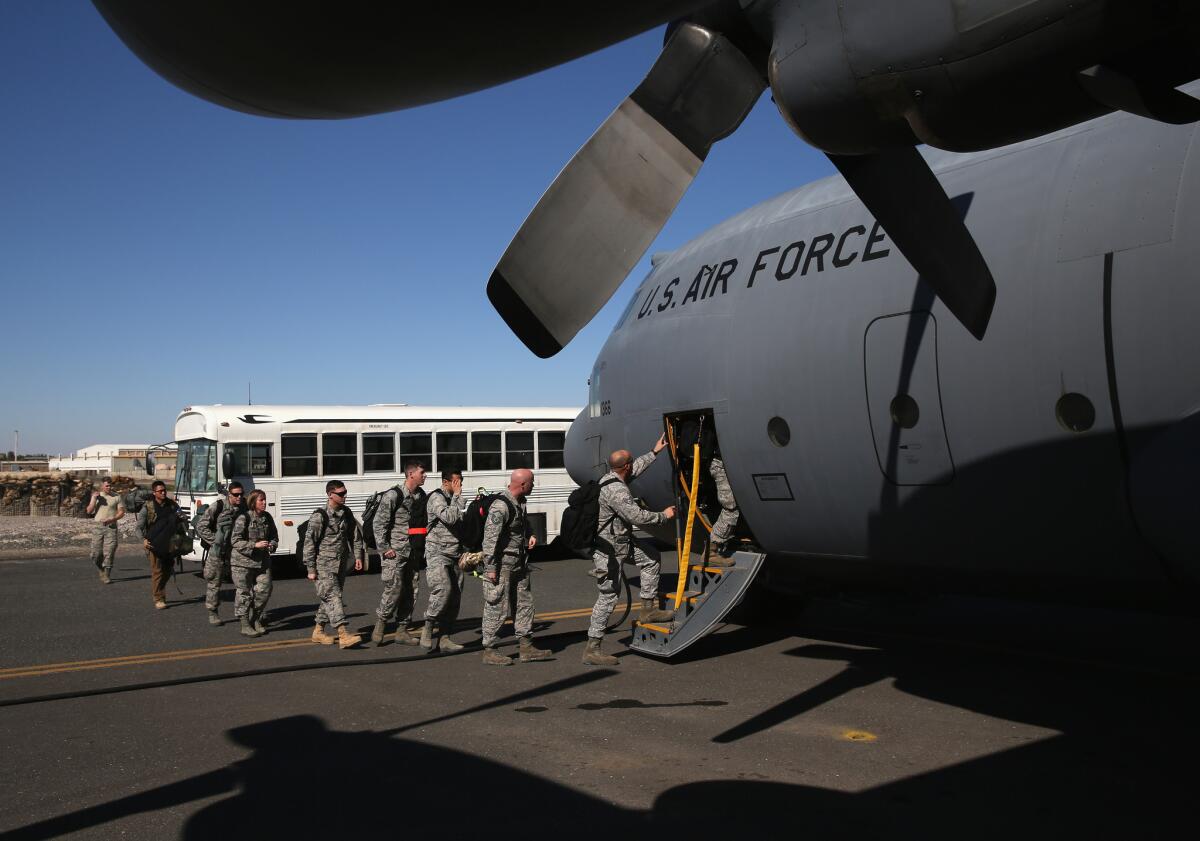Op-Ed: Should women register for the draft? That’s the wrong question to ask about our military.

U.S. military personnel board a Texas Air National Guard C-130 cargo plane bound for Iraq on January 10, 2016 from a base in an undisclosed location in the Persian Gulf region.
- Share via
Should the United States require women to register for the draft? The chief of staff of the U.S. Army and the commandant of the Marine Corps think so. As a result, presidential candidates are weighing in on this suddenly pressing issue. Jeb Bush, Chris Christie, and Marco Rubio are all for it. Ted Cruz derides the very idea as “nuts” and “immoral.” Hillary Clinton is not so sure. As for Donald Trump and Bernie Sanders, an anxious nation awaits their judgment.
A tempest in a canteen cup, to be sure. Yet it provides a classic illustration of how presidential campaigns trivialize American politics, with manufactured controversies distracting attention from genuinely substantive issues.
When last attempted, during the Vietnam War, conscription backfired. It spurred antiwar sentiment and benefited no one—apart perhaps from Canada, favored destination of many thousands of draft evaders. In 1973, the federal government conceded the point and abolished the draft altogether.
True, in response to the Soviet invasion of Afghanistan, a 1980 executive order restored a nominal requirement for 18-year old males to notify the Selective Service System of their availability. Ever since, most young men have duly complied, albeit less out of a sense of patriotism than to ensure their eligibility for obtaining a driver’s license. As a practical matter, however, the likelihood of federal authorities actually drafting anyone, regardless of gender, is essentially zero.
Civilian officials and military leaders alike have embraced the so-called All-Volunteer Force. So too have members of the public, happily accepting a revised definition of citizenship shorn of any obligation to contribute to the country’s defense. The All-Volunteer Force is now the Let-Someone-Else-Serve Force, a perfect fit for a Do-Your-Own-Thing Age.
This approach to filling the ranks continues to find superficial favor in both Washington and the hinterlands. Yet as with other policies – imposing mandatory minimum prison sentences on drug offenders, for example – popularity and expedience are not to be confused with fairness and effectiveness.
The All-Volunteer Force is now the Let-Someone-Else-Serve Force... The upwardly-mobile offspring of the American elite are largely absent from the ranks.
Judged relative to several obvious criteria, our existing military system leaves much to be desired. Consider the following questions:
Shouldn’t the composition of U.S. forces reflect the character of American society? If so, that’s certainly not the case today. The armed services do not “look like America.” With blue-collar jobs offering decent pay and benefits increasingly scarce, the military attracts the sons and daughters of the working class. It’s the kid who graduates from an inner-city or rural high school and doesn’t see opportunities close to home who signs up. But the upwardly-mobile offspring of the American elite are largely absent from the ranks. Put simply, those most likely to reap the benefits of all that this nation has to offer are those least likely to serve. For proof, look no further than the (non-existent) military records of those today vying for the presidency.
When the nation goes to war, shouldn’t it field soldiers in sufficient numbers to accomplish the mission? In that regard, the All-Volunteer Force has been found wanting. Once the Global War on Terrorism encountered unanticipated difficulties – simultaneous conflicts in Iraq and Afghanistan requiring more troops than those readily available – the Pentagon was unable to come up with the needed reinforcements. Volunteering for Fallujah or Kandahar turned out to have limited appeal. A nation of more than 300 million could not put even 1% in uniform.
The upshot? Troops subjected to the abuse of repeated combat tours, with private contractors picking up the slack. In both Iraq and Afghanistan, contractors – a.k.a., mercenaries – eventually outnumbered U.S. troops, a truly astonishing fact. Yet if privatizing war, with contractors performing tasks traditionally handled by soldiers, seemed like a clever idea, it yielded indifferent results at exorbitant taxpayer expense.
Given the sheer size of the Pentagon budget, shouldn’t U.S. forces win? The U.S. military possesses a considerable aptitude for toppling regimes and sowing chaos, as our several post-9/11 interventions attest. What it’s not so good at is putting countries back together again – a prerequisite for victory. Although other factors no doubt contribute to this disappointing record, the defects of the existing American military recruitment system must number among them.
Whether or not to support registering women is a sound bite question. How well our military system is performing is one worthy of sustained and serious discussion. That the candidates competing to become the next commander-in-chief will neither be asked nor answer such a question is itself a sad judgment on American politics.
Andrew J. Bacevich is professor emeritus of history and international relations at Boston University. His new book “America’s War for the Greater Middle East: A Military History” is due out in April.
Follow the Opinion section on Twitter @latimesopinion and Facebook
More to Read
A cure for the common opinion
Get thought-provoking perspectives with our weekly newsletter.
You may occasionally receive promotional content from the Los Angeles Times.






